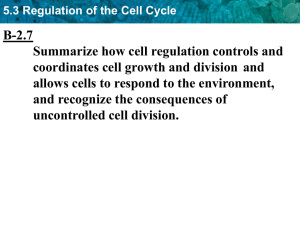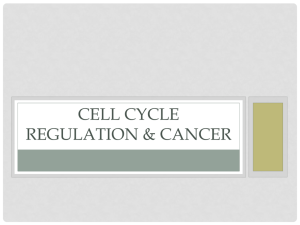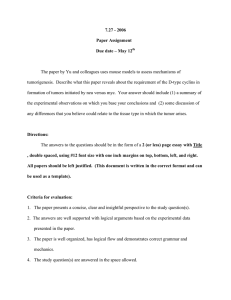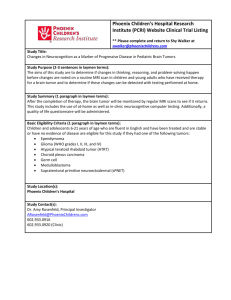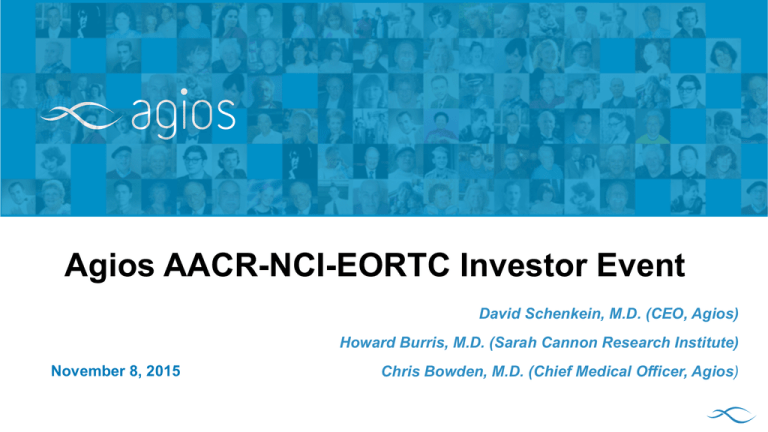
Agios AACR-NCI-EORTC Investor Event
David Schenkein, M.D. (CEO, Agios)
Howard Burris, M.D. (Sarah Cannon Research Institute)
November 8, 2015
Chris Bowden, M.D. (Chief Medical Officer, Agios)
Cautionary Note Regarding Forward-Looking Statements
This presentation and various remarks we make during this presentation contain forward-looking statements within the meaning of
The Private Securities Litigation Reform Act of 1995. Such forward-looking statements include those regarding the potential benefits
of Agios' product candidates targeting IDH mutations, including AG-120 and AG-881; its plans for the clinical development of AG-120
and AG-881; its plans regarding future data presentations; and the benefit of its strategic plans and focus. The words "anticipate,"
"believe," "estimate," "expect," "intend," "may," "plan," "predict," "project," "potential," "hope," "could," "would" and similar expressions
are intended to identify forward-looking statements, although not all forward-looking statements contain these identifying words. Such
statements are subject to numerous important factors, risks and uncertainties that may cause actual events or results to differ
materially from Agios' current expectations and beliefs. For example, there can be no guarantee that any product candidate Agios is
developing will successfully commence or complete necessary preclinical and clinical development phases, or that development of
any of Agios' product candidates will successfully continue. There can be no guarantee that any positive developments in Agios'
business will result in stock price appreciation. Management's expectations and, therefore, any forward-looking statements in this
press release could also be affected by risks and uncertainties relating to a number of other important factors, including: Agios' results
of clinical trials and preclinical studies, including subsequent analysis of existing data and new data received from ongoing and future
studies; the content and timing of decisions made by the U.S. FDA and other regulatory authorities, investigational review boards at
clinical trial sites and publication review bodies; Agios' ability to obtain and maintain requisite regulatory approvals and to enroll
patients in its planned clinical trials; unplanned cash requirements and expenditures; competitive factors; Agios' ability to obtain,
maintain and enforce patent and other intellectual property protection for any product candidates it is developing; Agios' ability to
maintain key collaborations, such as its agreement with Celgene; and general economic and market conditions. These and other risks
are described in greater detail under the caption "Risk Factors" included in Agios' Quarterly Report on Form 10-Q for the quarter
ended September 30, 2015, and other filings that Agios may make with the Securities and Exchange Commission in the future. Any
forward-looking statements contained in this press release speak only as of the date hereof, and Agios expressly disclaims any
obligation to update any forward-looking statements, whether as a result of new information, future events or otherwise.
2
What’s Possible: Our Vision & Science
November 8, 2015
David Schenkein, M.D.
Chief Executive Officer
We Are Driven By a Clear Vision and Values
VISION
Agios is passionately
committed to the fundamental
transformation of patients’ lives
through scientific leadership in
the field of cancer metabolism
and rare genetic disorders of
metabolism
4
What’s Possible for IDHm Patients
A Roadmap for Speed and Breadth
Goal
All IDHm patients screened and
treated with an IDHm inhibitor for
the entire course of their disease
Next
Frontline AML
Combination trials
Now
Maintenance
MDS
Other hematologic malignancies
Solid tumors
Relapsed/Refractory AML
5
What We Set Out to Do in Solid Tumors
Is safe in a
broader set of
patients
Show that AG-120:
Differentiation Restored
IDH
Isocitrate
mIDH
Lowers 2-HG
Epigenetic
“Re-Wiring”
Inhibitor
2HG
Gets in tumors
Normal Cell Death /
Homeostasis
Me Me
Me
Differentiation
aKG
Stem
Cell
6
Alters the
biology of
these diseases
Progenitor
Mature
Cell
Clinical Activity in Difficult-to-Treat Diseases
IHCC
•
A 65 year old female with IHCC previously treated with
cisplatin + gemcitabine à gemcitabine + oxaliplatin à
cisplatin + docetaxel, then received AG-120
•
98.7% reduction in tumor 2-HG level at C3D1
–
•
7
1740 ng/g compared to 135,000 ng/g at screening
81% reduction in Ki-67 staining
Glioma
Framing Today’s Data
•
•
•
•
What did we learn?
What are the key takeaways?
What do we still need to learn?
What are our next steps?
– Expansion phase is currently enrolling 4 cohorts each of 25 patients:
• Low grade glioma subjects with ≥ 6 months of prior scans
• 2nd-line cholangiocarcinoma subjects
• High grade metastatic chondrosarcoma subjects
• Cohort of solid tumor patients with IDH1 mutations not eligible for Arms 1-3
– A randomized phase 2 study of AG-120 in IHCC is planned for 2016
8
The First Reported Results of AG-120, a First-in-Class, Potent
Inhibitor of the IDH1 Mutant Protein, in a Phase 1 Study of Patients
with Advanced IDH1-Mutant Solid tumors, including Gliomas
Howard Burris1, Ingo Mellinghoff2, Elizabeth Maher3, Patrick Wen4,
Murali Beeram5, Mehdi Touat6, Jason Faris7, Nilofer Azad8,
Timothy Cloughesy9, Lia Gore10, Jonathan Trent11, Daniel Von Hoff12,
Meredith Goldwasser13, Hua Liu13, Bin Fan13, Bin Wu13, Sam Agresta13
1Sarah
Cannon Research Institute, Nashville, TN; 2Memorial Sloan Kettering
Cancer Center, New York, NY; 3University of Texas Southwestern Medical Center,
Dallas, TX; 4Dana-Farber Cancer Institute, Boston, MA; 5START Center for Cancer
Care, San Antonio, TX; 6Institut Gustave Roussy, Villejuif, France; 7Massachusetts
General Hospital, Boston, MA; 8Johns Hopkins Sidney Kimmel Comprehensive
Cancer Center, Baltimore, MD; 9Ronald Reagan UCLA Medical Center, Los
Angeles, CA; 10University of Colorado School of Medicine, Aurora, CO; 11Sylvester
Comprehensive Cancer Center, Miami, FL; 12Translational Genomics Research
Institute, Phoenix, AZ; 13Agios Pharmaceuticals, Cambridge, MA
Presented at the AACR-NCI-EORTC International Conference on Molecular Targets and Cancer Therapeutics, Boston, 5–9 Nov 2015.
Key Takeaways
• AG-120 is well tolerated in this solid tumor population
• AG-120 displayed favourable PK properties
• Reductions in plasma 2-HG are consistent with AG-120’s
inhibition of mutant IDH1 activity
– Reductions in intra-tumoral 2-HG observed with drug treatment
– MRS results suggest that AG-120 can lower 2-HG in the brain
• AG-120 shows encouraging signs of clinical activity
• Phase 2 dose has been selected – 500 mg QD
• Results warrant further study
10
Study Design
Single-arm, dose escalation, 3+3 study (ClinicalTrials.gov NCT02073994)
•
Key objectives:
– Safety and tolerability
– Identify the maximum tolerated dose (MTD) and/or recommended phase 2 dose (RP2D)
– Characterize pharmacokinetics, evaluate the pharmacokinetic/pharmacodynamic (PK/PD) relationship
(2-HG)
– Characterize preliminary clinical activity
•
Population:
– Patients with advanced solid tumors with an IDH1 mutation
•
Treatment:
– Single-agent AG-120 administered continuously, oral dosing once (QD) or twice (BID) daily in 28-day
cycles
– Eight dose levels explored: 100 mg BID, and 300, 400, 500, 600, 800, 900 and 1200 mg QD
•
Tumor assessments:
– RECIST v1.1 criteria for solid tumors other than glioma
– RANO criteria for glioma
11
RECIST, response evaluation criteria in solid tumors; RANO, response assessment in neuro-oncology
IDH Mutations Promote Oncogenesis in Solid and Hematologic
Malignancies
•
IDH mutations are hypothesized to be early and important transformational events that
remain important throughout the tumor life cycle
•
IDH mutations found in solid tumors are similar to those found in hematological cancers
•
Inhibition of αKG-dependent dioxygenases by excess 2-HG causes genetic and
epigenetic dysregulation, leading to oncogenesis
DIFFERENTIATION RESTORED
DIFFERENTIATION BLOCKED
Inhibitor
IDH
Isocitrate
mIDH
2-HG
Me Me
Stem
Cell
Normal cell death /
HOMEOSTASIS
Unchecked cell proliferation
Me
CANCER
Differentiation
αKG
12
Epigenetic
“re-wiring”
Progenitor
Mature
Progenitor
Cell
IDH1 Mutations Occur Across Multiple Solid Tumors
•
IDH1 mutations represent the majority (90-95%) in solid tumors compared to IDH2 mutations
in hematologic malignancies
•
Mutations are observed in several types of cancer that are difficult to treat, or for which there
is no standard therapy
Glioma
Intrahepatic cholangiocarcinoma
(IHCC)
Chondrosarcoma
Low grade and secondary GBM
Bile ducts
Cartilage
IDH1m frequency*
68–74%
11–24%
40–52%
IDH2m frequency*
3–5%
2–6%
6–11%
Tissue type
13
*Estimates continue to evolve with availability of new data. Images courtesy of T Cloughesy, J Trent & T Subhawong
IDH1 Mutations Drive Tumorigenesis in a Model of
Intrahepatic Cholangiocarcinoma
Repression of hepatocyte marker HNF-4α
Induction of differentiation along the
hepatocyte lineage with Agios
IDH1m inhibitor compound
Induction of hepatocyte marker HNF-4α
14
Reprinted by permission from Macmillan Publishers Ltd: NATURE 513:110-114, copyright 2014, Saha et al.
IDHm Inhibitor Responses in AML Are Fundamentally
Different from Chemotherapy
• Durable objective responses of 30–50% observed in IDHm+ AML
• AG-120 properties:
– Potent and reversible inhibitor of IDH1 mutants
– Cellular IC50 = 8–20 nM and selective against off-targets
– Orally bioavailable, long half life, low CNS penetration pre-clinically
Day 15 Marrow
IDHm inhibitor treatment
Evidence of appropriate differentiation &
maturation of mutated cells
15
Image: Min Xu M.D., data presented at AACR, Apr 2014
Day 15 Marrow
Conventional chemotherapy
Biopsy post conventional chemotherapy
shows an empty marrow
Disposition and Study Status
Dose escalation is complete, expansion phase has started at 500 mg QD*
Total enrolled, N=64
Treated subjects, n (%)
62 (100)**
100 mg BID
4
300 mg QD
9
400 mg QD
5
500 mg QD
24
600 mg QD
5
800 mg QD
6
900 mg QD
4
1200 mg QD
5
Disposition:
Subjects on treatment, n (%)
25 (40)
Discontinued subjects, n (%)
37 (60)
Primary reason for discontinuation, n (%)
Adverse event
Progressive disease
Withdrawal by subject
Other
16
3 (5)
30 (48)
2 (3)
2 (3)***
Percentages derived from total treated subjects. Cut-off date 3 Sep 2015
*In subjects with cholangiocarcinoma, chondrosarcoma, non-enhancing glioma, and other solid tumors with the IDH1 mutation
**Two patients were enrolled but had not received AG-120 at the time of data cut
***Lack of clinical benefit (n=1), clinical progression (n=1)
Baseline Characteristics
Total treated N=62
Median age, years (range)
56 (23–88)
ECOG status at baseline, n (%)
0
21 (34)
1
41 (66)
Gender (M/F)
29/33
Tumor types, n (%)
Cholangiocarcinoma
25 (40)
Chondrosarcoma
12 (19)
Glioma
20 (32)
Grade I-II
9
Grade III-IV
11
Other*
Median prior lines of therapy, n (range)
17
*Colitis-associated, neuroendocrine, adenocarcinoma, small intestine, and ovarian cancers
5 (8)
3 (1–6)
Safety Summary
• No DLTs observed
• MTD was not reached
• All SAEs occurred in one patient each (N=18/62):
– Acute kidney injury, acute respiratory failure, anemia, ataxia, brain herniation,
confusional state, cystitis, urinary tract infection, headache, hyponatremia, joint
effusion, esophageal varices hemorrhage, partial seizures, seizure, bacteremia,
superior vena cava syndrome, vertebral fracture, urosepsis
• No treatment-related deaths*
• Median duration of AG-120 exposure = 2 months (range 0-13)
• No dose reductions, 9 (15%) patients had dose interruptions
*2 deaths occurred > 20 days after last AG-120 dose. Neither were deemed related to treatment (anemia and
respiratory failure): 1 patient discontinued due to disease progression; 1 patient discontinued due to AE.
18
SAE, serious adverse event
Most Frequent Adverse Events
(In ≥10% of Patients, Regardless of Relationship) N=62
AG-120 well tolerated to date in this patient population
AE
All Grades, n (%)
55 (89)
Grade ≥3, n (%)
21 (34)
Nausea
16 (26)
-
Diarrhea
10 (16)
-
Vomiting
10 (16)
-
Anemia
9 (15)
3 (5)
Electrocardiogram QT prolonged
9 (15)
2 (3)
Fatigue
8 (13)
-
Headache
7 (11)
2 (3)
Peripheral edema
7 (11)
1 (2)
Abdominal pain
6 (10)
-
Ascites
6 (10)
1 (2)
Patients experiencing ≥1 AE
Most frequent AEs:
19
*Other Grade ≥3 events in ≥2 patients: hypophosphatemia 2 (3%), hyponatraemia 2 (3%)
PK/PD Supports 500 mg PO QD Dose for Expansion
Pharmacokinetics
• High plasma AG-120 exposure, above
projected efficacious level
• Long half life (71.4 ± 63.4 hr)
• Non-dose-proportional increases in
plasma exposure above 500 mg QD
Pharmacodynamics
• 2-HG inhibition is observed
• Plasma 2-HG reduced to levels seen
in healthy volunteers (up to 98%
inhibition)
20
2-HG in non-glioma patients
(Dosed at 500 mg QD)
Dashed line indicates average plasma 2HG levels in healthy volunteers
Box indicates median and inter-quartile range (IQR)
Whiskers extend to the highest/lowest value that is within 1.5*IQR
The number indicates the number of patients
Best Overall Response
(Efficacy Evaluable Patients1)
Chondrosarcoma
n=11
Cholangiocarcinoma
n=20
Glioma
n = 20
Other
n=4
Total
N=55
PR
-
1 (5)
-
-
1 (2)
SD
7 (64)
11 (55)
10 (50)
1 (25)
29 (53)
PD
2 (18)
6 (30)
10 (50)
3 (75)
21 (38)
UNK/Not Assessed
2 (18)
2 (10)
-
-
4 (7)
5/9 (56)
6/14 (43)
4/16 (25)
0/2
15/41 (37)
Best response, n (%)
Clinical Benefit Rate at
Month 62, n/N (%)
Glioma response assessments are based on RANO criteria; non-glioma are based on RECIST v1.1 criteria
Complete responses (CR) not observed
PR, partial response; SD, stable disease; PD, progressive disease; UNK, unknown
1Includes subjects who had baseline and at least one post baseline tumor assessment or discontinued prematurely
2Defined as CR/PR/SD; among subjects whose treatment started at least 6 months prior to the data cut-off date of 3 Sep 2015
21
Clinical Data from Non-Glioma
Patients
IDH Mutated Tumors Are Difficult to Treat
Intrahepatic Cholangiocarcinoma
•
•
2,000–4,000 new cases per year U.S.
50% of cases occur within the liver: IHCC
•
Prognosis: Worse for IHCC than other biliary
tract tumors
•
•
23
Typically presents with advanced disease
Prognosis: Poor 5-year survival
–
15–30% for local disease
–
2% for metastatic disease
Chondrosarcoma
•
•
700–1,000 diagnosed per year in the U.S.
Heterogeneous group of cancers
–
•
•
Arise from cartilage in bone and joint
3rd most common type of bone cancer
Prognosis: Based on disease burden
Images courtesy of Jonathan Trent & Ty Subhawong, Sylvester Comprehensive Cancer Centre
–
Curative potential with surgery, local disease
–
Low 5-year survival for metastatic disease
IHCC Patient with Partial Response
•
A 65 year old female with IHCC previously treated with cisplatin + gemcitabine
à gemcitabine + oxaliplatin à cisplatin + docetaxel, then received AG-120
•
98.7% reduction in tumor 2-HG level at C3D1
– 1740 ng/g compared to 135,000 ng/g at screening
•
81% reduction in Ki-67 staining
Screening
H&E
Ki-67
MRI
16.9%(+)
C5D1
C3D1
3.3%(+)
81%i
24
H&E, hematoxylin and eosin; PR, partial response; MRI, magnetic resonance imaging; C3D1, cycle 3 day 1
PR
Non-Glioma Solid Tumors: Best % Change in SLD of Target
Lesions
60
50
B est %
c h a n g e in S L D
40
Cholangiocarcinoma
Chondrosarcoma
Other
30
20
10
0
-1 0
-2 0
-3 0
-4 0
-5 0
Patients with ≥1 post-baseline tumor assessment shown
20% change is the RECIST threshold for PD and –30% change the RECIST threshold for PR
Graph shows best response at any single time point
25
SLD, sum of the longest diameter of the target lesions; PR, partial response; PD, progressive disease
Range for
Stable
Disease
Duration on Treatment: Non-Glioma Solid Tumors
26
All 42 treated patients as of data cut-off 3 Sep 2015; Median third line treatment (range 1-6)
PR, partial response; SD, stable disease; PD, progressive disease; UNK/NA, unknown/not assessed
Proliferation Inhibition and Reduction of 2-HG in Tumor
Tissue
Tumor type
Assigned
dose
Best
response
Treatment
duration
(weeks)
Ki-67
(% reduction)
Tumor 2-HG
(% reduction)
Cholangiocarcinoma
100 BID
SD
54
22
NA
Cholangiocarcinoma
300 QD
PR
41
81
99
Cholangiocarcinoma
500 QD
SD
32
55
NA
Chondrosarcoma
100 BID
SD
33
96
73
Chondrosarcoma
400 QD
SD
33
77
NA
• Proliferation assessed by IHC for presence of Ki-67 marker
• Staining evaluated by digital image analysis within region of cancer
• Reduction in Ki-67 staining and 2-HG expressed as % decrease at
cycle 3 day 1 (C3D1) compared to screening
27
Image analysis performed using ImageScope software (Aperio)
PR, partial response; SD, stable disease; NA, not available
Clinical Data from Glioma Patients
IDH1m Glioma Is a Unique Development Opportunity
•
•
Prevalence: 68–74%
Varying degrees of tumor aggressiveness
– Slower growing: low-grade glioma (LGG) are WHO Grades 1 and 2
– Rapidly progressive: high-grade glioma (HGG) are WHO Grades 3 and 4
•
•
Long-term prognosis is poor: 5-year survival rate of 33%
Median survival: 12–15 months for glioblastoma and 2–5 years for
anaplastic glioma
In c id e n c e o f ID H 1 m u t a t io n s in tw o g lio m a s e r ie s
P r i m a r y g li o b la s t o m a ( g r a d e I V )
S e r ie s 1 ( I c h im u r a )
S e r ie s 2 ( B a ls s )
S e c o n d a r y g li o b la s t o m a ( g r a d e I V )
A n a p la s t i c o li g o a s t r o c y t o m a ( g r a d e I I I )
A n a p la s t i c o li g o d e n d r o g li o m a ( g r a d e I I I )
A n a p la s t i c a s t r o c y t o m a ( g r a d e I I I )
O li g o a s t r o c y t o m a ( g r a d e I I )
O li g o d e n d r o g li o m a ( g r a d e I I )
D if f u s e a s tr o c y to m a ( g r a d e II)
0
20
40
60
80
100
No IDH1 mutations
were identified in
ependymoma,
meningioma or
medulloblastoma
samples
F re q u e n c y (% )
29
Data from: Ichimura et al. Neuro-Oncology 2009;11:341–347; Balss et al. Acta Neuropathol 2008;116:597-602
IDH1m Gliomas Have Distinct MRI Appearance
30
•
Decreased contrast enhancement, increased non-contrast enhancing tumor, decreased
necrosis and edema, increased cysts, diffuse component, and increased tumor size in IDH
mutant disease
•
MR spectroscopy (MRS) may serve as an adjunct to conventional imaging to understand 2-HG
response in IDH-mutant glioma
Reprinted with permission. © 2011 American Society of Clinical
Oncology. All rights reserved. Lai et al. J Clin Oncol. 29:4482-4490.
Evidence for Sequenced Molecular Evolution of IDH1 Mutant
From Andronesi et al. Sci Transl Med 2012;4:116.
Glioblastoma From a Distinct Cell of Origin
Reprinted with permission from AAAS
Glioma: Best % Change in SPD*
175
150
B est %
c h a n g e in S P D
125
Tumor grade 2, low grade
Tumor grade 3/4, high grade
100
75
50
25
0
-2 5
-5 0
-7 5
-1 0 0
-1 2 5
Patients with ≥1 post-baseline tumor assessment shown
25% change is the RANO threshold for PD and –50% change the RANO threshold for PR
Graph shows best response at any single time point
31
*SPD, sum of the product of diameters; PR, partial response; PD, progressive disease
Range for
Stable
Disease
Glioma: Duration on Treatment
All 20 treated patients as of data cut-off 3 Sep 2015. SD, stable disease; PD, progressive disease
32
2D MRS (TE=97 ms)
38 year old male
with Grade II glioma
33
1D MRS (TE=97 ms)
Volumetric Change Observed Consistent with 2-HG MRS
Reduction
Pre-treatment
2-HG
On treatment
2-HG
Pre-AG-120 treatment
Pre treatment
On treatment
Data from Dana Farber Cancer Institute (P Wen, R Huang, A Lin)
Tumor volume
Assessing AG-120 Treatment Impact with Volumetric, MRS
and SPD Analyses
Grade II
oligoastrocytoma
Max
Volume
Change
Max 2-HG
Change
by MRS
Best
SPD
Change
Grade II
oligodendroglioma
−64%
−100%
−30%
−19%
−53%
+3%
+73%
+37%
−2%
Grade III anaplastic
oligoastrocytoma
Pre-AG-120 treatment
34
Data from Dana Farber Cancer Institute (P Wen, R Huang, A Lin)
SPD, sum of the product of diameters
Putting the Data in Clinical Context
• Excellent safety profile provides potential to combine with:
– Chemotherapy
– Immuno-oncology
– Radiation
– Novel-novel across all solid tumor indications
• Clinical activity observed has applications across multiple indications
– Surgically managed diseases
• Neo-adjuvant approach with chemotherapy – goal is to cure people
• Adjuvant treatment – goal is to improve survival
• Unique opportunity to understand treatment impact on gliomas via volumetric
analysis, MRS of 2-HG, etc.
35
IDH Development in Solid Tumors
November 8, 2015
Chris Bowden, M.D.
Chief Medical Officer
Developing IDHm Inhibitors in Solid Tumors
• Uncharted development
area
withandnew
biology
IDH mutations both found
in blood
solid cancer,
clinical development programs and timelines are different
• LGG, IHCC and chondrosarcoma have poor treatment
options and limited drug development precedent
Realizing the full potential of targeting IDH mutations is
a long-term proposition
• Significant opportunity to develop targeted therapies across
IDHm solid tumors
• Multiple clinical development programs ongoing and
planned to address broad range of solid tumors
37
Changing the Natural History of IDHm Solid Tumors
Our vision is to develop a foundational therapy used through multiple stages of
any IDHm tumor where POC is established
Adjuvant
Post-resection to prevent
recurrence à potential cure
Frontline
Suppress driver mutation as
monotherapy or in combination
with other agents à improve
survival
Relapsed/Refractory
Setting
38
Glioma: Surgical Resection Is Mainstay of Treatment
Followed by Radiation and/or Chemotherapy
Treatment Algorithm for Glioma
• Newly diagnosed
– Surgical intervention
– Treatment post-surgery
depends on grade
• Observation alone
• Chemotherapy
• Radiation (RT)
• Chemotherapy plus RT
• Limited effective treatment
options for progressive
disease
39
Nat Rev Neurol. 2013 Mar;9(3):141-51.
Chondrosarcoma: Surgery Is Only Curative Option
•
Surgery is the mainstay of
treatment
– Complete surgical
resection curative, but
not possible in
advanced disease
•
Radiation is not effective
•
Chemotherapy is of
limited benefit
– Primarily used in
neoadjuvant setting to
convert nonresectable
to resectable
•
40
Treatment for metastatic
disease is mainly
palliative
1st graph: Italiano A, Annals of Oncology 2013; 2nd graph: Wagner 2013 CTOS Presentation
Metastatic Cholangiocarcinoma: Options Are Limited to
Gemcitabine-Based Regimens
• Surgery possibility curative, if not
metastatic
– IHCC has the lowest resectability
rates (due to late presentation)
Randomized, Frontline Phase 2 study
including 86 patients comparing cisplatin plus
gemcitabine with gemcitabine alone in patients
with previously untreated locally advanced or
metastatic biliary tract cancer
– Five-year OS post-resection: 14-40%
– Majority of patients recur despite
complete resection
• Cisplatin plus gemcitabine standard
of care for newly diagnosed
metastatic disease
Valle J. N Engl J Med. 2010.
41
What We Expect to Learn: Phase 1 Expansion
Phase 1 Expansion Cohorts (25 patients/cohort)
Cohorts
Potential Learnings
•
1. Low grade glioma patients with ≥ 6 months of prior
scans
2. 2nd-line cholangiocarcinoma patients
•
•
•
Further assess epigenetics remodeling and antiproliferative effects of AG-120 at the tissue level
•
Pilot efficacy and safety in low IDHm prevalence
settings (e.g., breast cancer, colorectal cancer)
3. High-grade metastatic chondrosarcoma patients
4. Cohort of solid tumor patients with IDH1 mutations
not eligible for Arms 1-3
42
Improved understanding of radiographic
(volumetric) course of disease
2-HG MRS in predicting clinical activity
Development of new endpoints
What We Expect to Learn: Randomized Phase 2
Randomized
Phase 2 in
IHCC
43
• Direct comparison of AG-120 vs.
a control
• Potential of AG-120 to improve
disease control rate
Clinical Development Path in IDH1m Solid Tumors Will Be
Data Driven
AG-120
Dose-Escalation
(Completed)
Expansion
(Ongoing)
IDH1m inhibition;
Lower CNS
penetration
Randomized
IHCC Phase 2
(Planned)
AG-881
Pan-IDHm
inhibition;
High CNS
penetration
44
AG-881 Phase 1
Dose-Escalation
(Ongoing)
Potential
Expansion
IHCC
Chondro
sarcoma
Glioma
Other
IDHm
Solid
Tumors
Novel First-in-Class Clinical Portfolio
Candidate
Indication
Early Stage
Clinical Development
R/R AML
R/R AML
Expansion Cohorts
Phase 1 Dose Escalation
Frontline AML
Phase 1b Combinations (Q4’15)
(IDH2m inhibitor)
Frontline AML
Phase 1/2 Combinations (Q1’16)
Solid Tumors
Phase 1 Expansion
Agios U.S. Co-promotion and Royalty
Phase 1 Dose Escalation
AML
R/R AML
Phase 3 (1H’16)
Dose Escalation
Expansion Cohorts
AG-120
MDS/Heme Malig
(IDH1m inhibitor)
Frontline AML
Phase 1b Combinations (Q4’15)
Frontline AML
Phase 1/2 Combinations (Q1’16)
Solid Tumors
Phase 1 Dose Escalation
IHCC
Phase 1 Expansion
R/R AML
Phase 1 Dose Escalation
(pan-IDHm inhibitor)
Solid Tumors
Phase 1 Dose Escalation
AG-348
PK Deficiency
AG-519
PK Deficiency
(PK (R) Activator)
U.S. Rights
EX-U.S.
Expansion Cohorts
Phase 2 (2016)
AG-881
(PK (R) Activator)
Primary Commercial Rights
Phase 3
AG-221
MDS/Heme Malig
Late Stage
Clinical Development
Phase 2 DRIVE PK
Phase 1 (Q1‘16)
Joint Worldwide Collaboration
What’s Next at ASH
• 7 abstracts accepted
- Four for AG-221 and
AG-120, including new
data from dose
escalation and
expansion cohorts
- Three for PK
deficiency program,
including PK/PD data
for AG-348 and natural
history study findings
46

